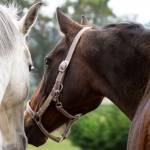Unusual Jaw Conformation in Horses

A horse whose top and bottom incisors do not come in contact with one another is said to have a malocclusion. Slight malocclusions often have no associated health problems, but those horses with severe cases might have trouble grazing and grinding feedstuffs.
The most common jaw deformity is parrot mouth, in which the maxilla (upper jaw) extends beyond the mandible (lower jaw). In contrast to a parrot mouth, monkey or sow mouth indicates a condition in which the mandible extends beyond the maxilla. Monkey mouth is less common than parrot mouth. Both conditions are thought to be inherited.
Because malocclusions are thought to be passed from one generation to the next, the teeth of mares and stallions showing in conformation classes are frequently examined by judges. Presence of a malocclusion is often reason enough for a horse to be excused from a class. For example, the American Quarter Horse Association (AQHA), which is the largest breed organization in the world and sanctions thousands of shows annually, considers the fault an undesirable trait. Judges officiating at AQHA-approved events are instructed to dismiss from the ring any mare or stallion that has an overshot or undershot jaw.
Potential breeding stock should be evaluated for jaw malformations.








